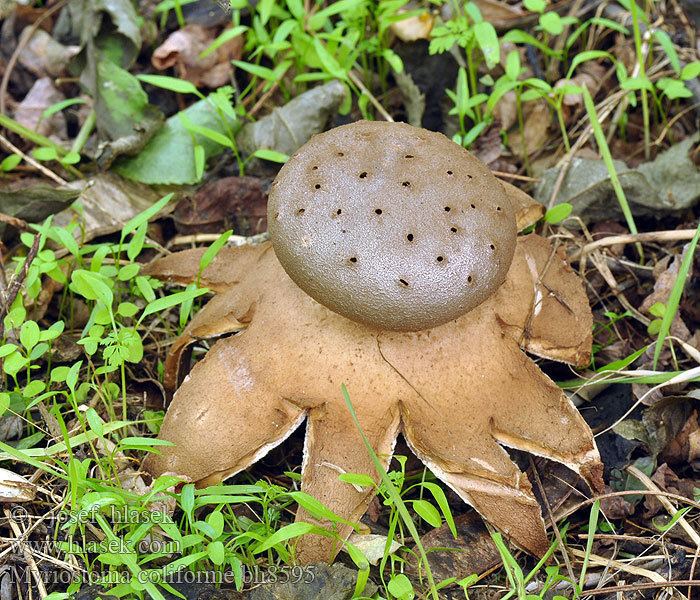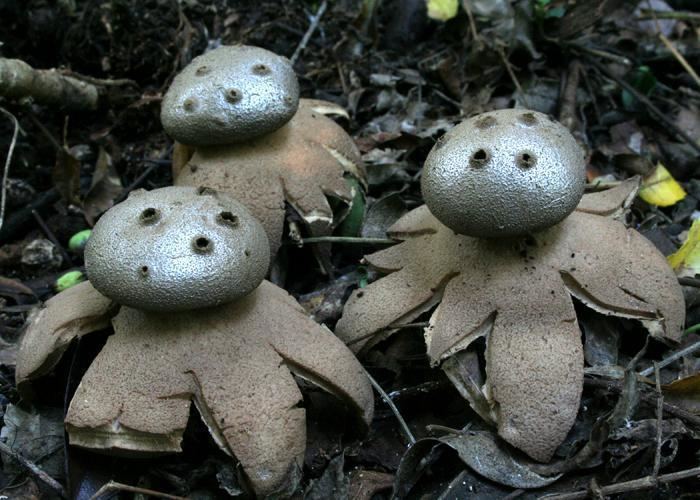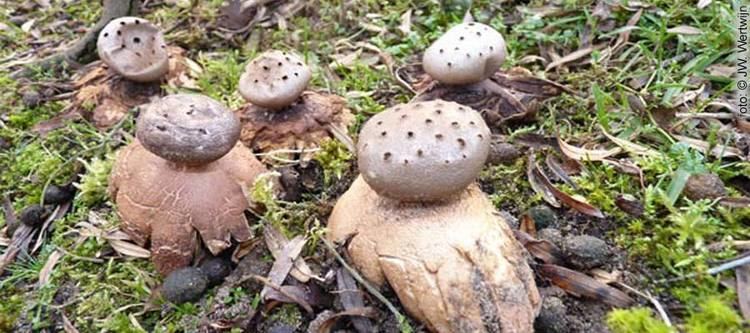Kingdom Fungi Scientific name Myriostoma Rank Genus | Division Basidiomycota Family Geastraceae Higher classification Geastrales | |
 | ||
Similar Geastrales, Geastrum, Basidiomycota, Tulostoma, Geastrum fornicatum | ||
Myriostoma is a fungal genus in the family Geastraceae. The genus is monotypic, containing the single species Myriostoma coliforme. It is an earthstar, so named because the spore-bearing sack's outer wall splits open into the shape of a star. The inedible fungus has a cosmopolitan distribution, and has been found in Africa, Asia, North and South America, and Europe, where it grows in humus-rich forests or in woodlands, especially on well-drained and sandy soils. A somewhat rare fungus, it appears on the Red Lists of 12 European countries, and in 2004 it was one of 33 species proposed for protection under the Bern Convention by the European Council for Conservation of Fungi.
Contents

The fruit body, initially shaped like a puffball, is encased within an outer covering that splits open from the top to form rays. These rays curve down to expose an inner papery spore case, which contains the fertile spore-bearing tissue, the gleba. The fungus is unique among the earthstars in having a spore case that is supported by multiple stalks, and is perforated by several small holes suggestive of its common names salt-shaker earthstar and pepperpot. It is the largest of the earthstar fungi, and reaches diameters of up to 12 cm (4.7 in). Its spherical spores have elongated warts that create a ridge-like pattern on their surface. The spores are dispersed when falling water hits the outer wall of the spore sac, creating puffs of air that force the spores through the holes.

Taxonomy and phylogeny

The species was first mentioned in the scientific literature by Samuel Doody in the second edition of John Ray's Synopsis methodica Stirpium Brittanicorum in 1696. Doody briefly described the mushroom like so: "fungus pulverulentus coli instar perforatus, cum volva stellata" (mushroom dusty, like a perforated colander, volva star-shaped), and went on to explain that he found it in 1695 in Kent.

It was first described scientifically as a new species in 1776 from collections made in England by James Dickson, who named it Lycoperdon coliforme. He found it growing in roadside banks and hedgerows among nettles in Suffolk and Norfolk. Nicaise Auguste Desvaux first defined and published the new genus Myriostoma in 1809, with the species renamed Myriostoma anglicum (an illegitimate renaming). Christian Hendrik Persoon had previously placed the species in Geastrum in 1801, while Samuel Frederick Gray would in 1821 describe the genus Polystoma for it. Myriostoma coliforme received its current and final name when August Carl Joseph Corda moved Dickson's name to Myriostoma in 1842, replacing Desvaux's name.
In North America the fungus began to be reported in the late 19th century, first from Colorado by Charles Horton Peck, and later from Florida, collected by Lucien Underwood in 1891; both findings were reported by Andrew Price Morgan in April 1892. In 1897, Melville Thurston Cook also reported having collected it the year before from "Albino Beach". Curtis Gates Lloyd described Bovistoides simplex from a South African specimen in 1919, but in 1942, William Henry Long examined that specimen and concluded that it was a weathered spore sac of M. coliforme that had become detached from the outer star-shaped exoperidium. This conclusion was confirmed in a later study of the material.
Myriostoma had been classified in the Geastraceae family until 1973, when British mycologist Donald Dring placed it in the Astraeaceae based on the presence of trabeculae (stout columns that extend from the peridium to the central core of the fruit body) in the gleba, and the absence of a true hymenium. In his 1989 monograph, Stellan Sunhede returned it to the Geastraceae. Molecular analysis of DNA sequences has confirmed the traditional belief that Myriostoma and Geastrum are closely related.
Václav Jan Staněk proposed a variety capillisporum in 1958, which has been sunk back into synonymy with the species. M. coliforme is the sole species in Myriostoma, making the genus monotypic. Because the original type material has been lost, in 1989 Sunhede suggested that Dickson's illustration in his 1776 publication (tab. III: 4a & b) be used as the lectotype.
The specific epithet is derived from the Latin words colum, meaning "strainer", and forma, meaning "shape"—Berkeley's vernacular name "Cullenden puff-ball" also refers to a colander. Gray called it the "sievelike pill-box". The generic name is from the Greek words μνριός, meaning "countless" and στόμα, meaning "mouth" (the source of the technical term stoma). The species is commonly known as the "salt-and-pepper shaker earthstar" or simply the "pepperpot".
Description
The fruit bodies start their development underground or buried in leaf debris, linked to a strand of mycelium at the base. As they mature, the exoperidium (the outer tissue layer of the peridium) splits open into 7 to 14 rays which curve backward; this pushes the fruit body above the substrate. Fully opened specimens can reach dimensions of 2–12 cm (0.8–4.7 in) from ray tip to tip. The rays are of unequal size, with tips that often roll back inward. They comprise three distinct layers of tissue. The inner pseudoparenchymatous layer (so named for the resemblance to the tightly packed cells of plant parenchyma) is fleshy and thick when fresh, and initially pale beige but darkening to yellow or brown as it matures, often cracking and peeling off in the process. The exterior mycelial layer, often matted with fine leaf debris or dirt, usually cracks to reveal a middle fibrous layer, which is made of densely packed hyphae 1–2.5 μm wide. The base of the fruit body is concave to vaulted in shape, and often covered with adhering dirt. The roughly spherical spore sac (endoperidium) measures 1–5 cm (0.4–2.0 in) in diameter, and is supported by a cluster of short columns shaped like flattened spheres. It is gray-brown in color, and minutely roughened with small, lightly interconnected warts. There are several to many evenly dispersed mouths, the ostioles, mainly on the upper half of the endoperidium. They are roughly circular with fimbriate (fringed) edges. The inedible fruit bodies have no distinct taste, although dried specimens develop an odor resembling curry powder or bouillon cubes.
Like many earthstars, the fungus uses the force of falling raindrops to help disperse the spores, which are ejected in little bursts when objects (such as rain) strike the outer wall of the spore sac. The gleba is brown to grayish-brown, with a cotton-like texture that, when compressed, allows the endoperidium to flex quickly and create a puff of air that is forced out through the ostioles. This generates a cloud of spores that can then be carried by the wind. There are columellae (sterile structures that start at the base of the gleba and extend through it), which are usually not evident in the mature gleba, but apparent at the base of the spore sac. The columellae are not connected to the ostioles, but rather, terminate within the gleba at some distance from them. The capillitia (sterile strands within the gleba) are long, slender, free, tapering, unbranched, and 2–5 μm thick, with thickened walls. The spores are spherical, nonamyloid, and are ornamented with irregularly shaped flaring protuberances up to 2 μm high. They measure 3.9–4.8 μm in diameter (without ornamentation), and 5.4–7.0 μm including the ornamentation.
Similar species
Myriostoma coliforme is a distinctive species easily characterized by its size—being the largest earthstar fungus—as well as the multiple openings on its spore sack and stalk supporting the sack. Historically, it was thought that the holes might have been a result of insects. This was discussed and rejected by Thomas Jenkinson Woodward in 1797:
It has been doubted whether these mouths might not be accidental, and formed by insects after the expansion of the plant. But this (not to mention their regularity, and that each is furrowed by its border of ciliae) is clearly disproved, from the marks of the projections formed by the mouths being seen on the expanded rays, when freshly opened ... I have likewise found an abortive plant, in which the seed did not ripen; but which had numerous projecting papillae on the head, where the mouths should have been formed.
Habitat and distribution
Myriostoma is saprobic, deriving nutrients from decomposing organic matter. Fruit bodies grow grouped in well-drained or sandy soil, often in the partial shade of trees. The species occurs in deciduous forests and mixed forests, gardens, along hedges and grassy road banks, and grazed grasslands. In the Northern Hemisphere, it tends to grow on well-drained south-facing slopes, while it prefers a similar habitat on north-facing slopes in Australia. In Europe, its major habitat is riparian mixed forests dominated by Salix alba and Populus alba along the great rivers. In Hawaii, it has been collected at elevations above 2,000 m (6,600 ft) where it appears to favor the mamame (Sophora chrysophylla) forest.
The species is widespread, being known in its natural habitat from all five continents, but is not found in abundance. Myriostoma coliforme is rare in Europe, where it appears on the Regional Red Lists of 12 countries, and is one of 33 candidate species for listing in Appendix I of the Convention on the Conservation of European Wildlife and Natural Habitats (the "Bern Convention"). Although originally described from England, it was considered extinct in mainland Britain until it was found again in Suffolk in 2006 near Ipswich, one of its original localities—it had been last reported in the country in 1880. The fungus is considered extinct in Switzerland. Its most northerly location is southern Sweden, although it is generally rare in northern Europe. It is similarly widespread but rarely encountered in North America, although there may be isolated localities, like New Mexico, where it is more abundant. In Australia, where its range is limited to the central New South Wales coast, it may have been introduced from exotic plant material.
